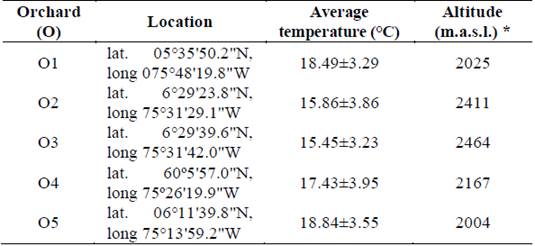1. Introduction
In recent years, Colombia has become a new exporter. Colombia has established itself in the fresh fruit markets in Europe, the U. S., Canada, Western Asia (UAE), and Latin America (Costa Rica, Argentina, and Panama) and is negotiating with other countries (China, Korea, Japan, etc.). According to CORPOHASS [1], Hass avocado (Persea americana Mill) production is an important farmer of rural employment.
Hass avocado consumption is growing globally. It is well known that sensory quality affects consumer acceptance. Other authors worked to establish the harvest index for California Hass avocados and related it to dry matter and taste [2], found that a dry matter content of 20% gave an acceptable taste. Exporter countries such as Mexico, Chile, and South Africa, among others, have conducted research to establish their own harvest indexes. Researcher have reported 23.0% dry matter (DM) as appropriate for harvesting Hass avocados in Colombia [3,4]. Because DM has a high linear relationship with oil content (OC), at 23% of DM, it is possible to have 11.2% OC. This value is used commercially as a reference to assure good taste and sufficient ripening of avocados. However, because OC is not adaptable to field conditions, growers prefer to analyze DM.
Around the world, the Hass avocado harvest season is divided into three maturity stages: early, middle and late. A research showed that consumer preferences and purchase intent increase throughout the harvest season for Australian Hass avocados [5]. Additionally, researchers did not find significant differences in the external and internal attributes of avocados from Almerı́a (Spain) [6]. Both studies were performed without storage before ripening. Other researchers found that storage affects Hass avocado internal quality including internal disorders (vascular browning) and diseases (stem end and body rots) [7]. Nonetheless, there are no sensory studies on Hass avocados grown in tropical conditions. Colombia because of its geographical position has different field conditions (rainfall, altitude, temperature, relative humidity, solar radiation, photosynthetically active radiation, etc.) compared to other Hass avocado origins (Chile, Australia, South Africa, Mexico, and Peru). Growing regions such as Antioquia have high rainfall (annual average 2500 mm) and a wide altitude range (1900-2500 meters above sea level, m.a.s.l.), and the value chain does not establish plant breeding and orchard management practices focused on fruit quality [8,9] Thus, orchard exporters have many fruit setting periods that could introduce high heterogeneity in harvesting. Our hypothesis was that sensory quality descriptors and general quality could be affected by localities, harvest season and storage duration. Therefore, the aim of this work was to evaluate the effect of harvest index (19, 22, 26 and 30% DM) and storage duration (0, 3, 4 and 5 weeks) on Hass avocado (Persea americana Mill) sensory quality.
2. Materials and methods
2.1. Sampling
Avocado fruits were taken from 5 orchards located in Antioquia (Colombia) in 2016-2017 (Table 1). Each orchard had a GLOBAL GAP (Good Agricultural Practices) certificate and exported to Europe. The orchards were selected according to Tamayo-Vélez and Osorio, [10] as follows: comparable nutrient management, without irrigation or hormone supplements, and were only subjected to annual light correctional pruning. Trees (30) were randomly selected with a productive age from 7-10 years. Before sampling, fruits were labeled in the peduncle after the fruit set period. Fruit equatorial diameter (20-23 mm) was used to start to follow the fruit development [11]. Periodically, DM content was determined by the AOAC Method [12].
2.2. Harvest maturity follow-up
Five fruits were sampled every 15 d before each harvest season to measure dry matter as a maturity index. Fruits were sent to Agrosavia Research Center “La Selva” (Rionegro, Antioquia Colombia). DM content was analyzed according to the AOAC No. 934.01 method [12].
2.3. Harvest, postharvest conditioning, and fruit ripening
Once fruit reached 19, 22, 26 and 30% DM, the fruit peduncle was cut manually at 5 mm with disinfected pruning scissors. Fruits were harvested in the morning to avoid humidity and prevent lenticel damage. Samples were sent to Agrosavia (research center “La Selva”, Rionegro, Colombia) facilities for conditioning, ripening and further analysis.
The condition of the avocado fruits simulated export conditions. Fruits were disinfected by immersion (30 s) into a prochloraz solution (0.05% w/v Mirage ® Adama Andina). Then, the fruit were dried at room temperature and packed in carton boxes. After that, samples were stored (0, 3, 4 and 5 weeks) at controlled temperature and humidity (5°C/ 90% relative humidity, RH, Memmert HPP 110). Ripening was performed at 20°C and 90% RH and ended when the fruit were at a rating of 5 [13]. Ripe fruit were sent to the sensory analysis laboratory of Universidad de Antioquia (Medellín, Colombia).
2.4. Sensory analysis (SA)
Before SA, samples were cut longitudinally in two halves and peeled. Fruits with any internal diseases or physiological disorders were separated. For avocados without damage, 29 descriptors were analyzed by a trained sensory panel in the Universidad de Antioquia following the methods of the ISO [14] for the multidimensional profile test. Descriptors of appearance, smell, taste, and texture were evaluated on a scale from 0 to 5, and general quality was evaluated (GQ) from 0 to 3, where 3 is high GQ and 1 is low GQ.
2.5. Statistical analysis
The results were analyzed by principal component analysis (PCA) and PLS-DA using SIMCA P software (StatPoint Technologies, Warrenton, VA). The best variables to fit the GQ and sensory descriptors were selected with the LEAPS model (software R), and then a multiple linear regression was performed with the chosen variables (Statgraphics Centurion XVI). Finally, surface response analyses were performed to determine the combination of factors to reach better GQ (Design Expert 11, Stat Ease Minneapolis, US).
3. Results and discussion
Fig. 1 shows that fruit harvested at 19% DM have a green taste, bitter sensation, hard texture, spicy sensation, and wet texture. Fruits with 19% DM were in the first component at the far end of general quality. Some fruits of the orchards O1,O2 and O4 at 22% DM have the same scores for those descriptors. However, these orchards have different average temperatures and altitudes. In general, fruits harvested at 19% and stored at different times do not reach a sensory quality related to good general quality. O4 at different HIs (Harvest Indexes) was on the left side of the first component (bitter smell, fibrous texture, green smell, acid taste, acid smell and umami taste). The right side of the first component was related to general quality (Fig.1A). Descriptors such as color uniformity, fresh appearance, and fruity and floral smell were close to GQ (Fig. 1B). The hard and wet textures were separated in the second component from oily and, flux textures. Oily, fruity, and floral tastes were separated in both components from bitter taste and green taste.
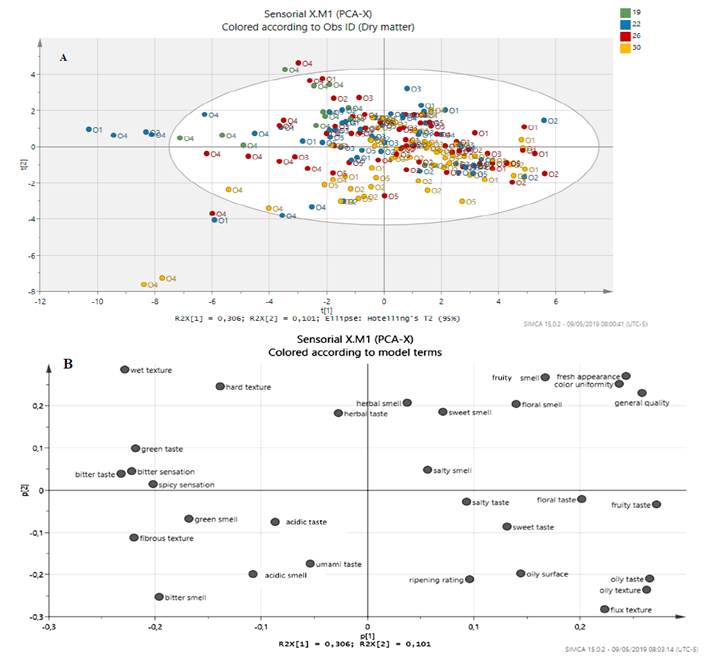
Source: The authors.
Figure 1 Principal component analysis biplot chart for DM and sensory descriptors: A) score scatter plot and B) loading scatter plot.
Colombia currently does not have a specialized standard for Hass avocado quality. Thus, each packing house has its own value of DM for harvesting according to the market. Moreover, growers do not fully understand the impact of harvest maturity on fruit sensory quality. The results show that 19% DM is not a good value at which to harvest avocados in Colombia. All the descriptors of the fruit harvested at 19% DM are not related to good general quality. Results agree with other works published with avocado from California USA [3,15], Mexico, Chile, Peru [16], and Spain [6]. Those researches have reported that the green flavor, watery texture, grassy flavor are characteristic descriptors of immature avocado (DM 19%). As maturation progressed sensory panelists found the likeability of the fruit to increase, coinciding with the fruit becoming creamier and less watery in texture, and the flavor richer and less grassy. However, in this work more descriptors are reported to the sensory quality profile related to the harvest indexes (spicy sensation, green taste, bitter taste, flux texture, color uniformity, etc.) (Fig.1).
Our work differs from previous researches because of the use of the sensory profile test by multidimensional approach instead of the preferences test and the multivariate data analysis approach. This sensory test is often applied for detailed description of the sensory characteristics of a product. In this method, an assumption is accepted that sensory quality is not a single attribute, but it is a complex of many descriptors which can be individually estimated by a panel [17]. Moreover, in sensory analysis, it is common not to observe differences among means when a test of liking of an attribute is assessed because data have a great variability but if an PCA or PLS are applied to data, remarkable differences can be observed in a 2D scatter and loadings plots [18].
Even though GQ improved throughout (22% DM to 30% DM) the harvest season (Fig. 1), the results show that fruit at 22% DM have the same sensory quality descriptors as fruit harvested at 26% and 30% DM, O1 and O2, respectively (Fig. 1A). These results disagree with some researchers, who sampled Hass avocados from different states and locations around Australia on the assumption that they would provide the required range of maturity levels for the study, minimizing the extent that any one orchard would unduly affect the results [5]. Hass Avocado sensory quality could be affected by the natural ripening heterogeneity as a response of the fruit metabolism. Targeted and untargeted metabolomics studies during avocado ripening have revealed several metabolites, mainly amino acids, that were related to ripening heterogeneity and differentially accumulating of linoleic acid [19]. More studies are needed to identify others unidentified discriminant markers between growing seasons of Hass avocado [20]. which could explain the sensory differences observed at the same harvest period in this work.
PLS Regression is useful in sensometrics when predictive variables are intercorrelated. Furthermore, it may be useful to guide the selection of a subset of relevant attributes from the complete set of attributes [21]. In this case a PLS model was used to establish descriptors related to DM. Fig. 2, represents the score and loading scatter plots of PLS. The main influential descriptors for the model were selected for the VIP scores (score cutoff 1.0), which were wet texture, fruity smell, flux texture, herbal smell, oily taste, bitter sensation, bitter taste, oily texture, umami taste, sweet taste, general quality, fruity taste and oily surface. Low DM values are related to a wet texture, bitter sensation, and bitter taste. High DM values are related to flux texture, oily taste, oily texture, and sweet taste. It was also seen that the fruit farmer has an effect on the sensory quality.
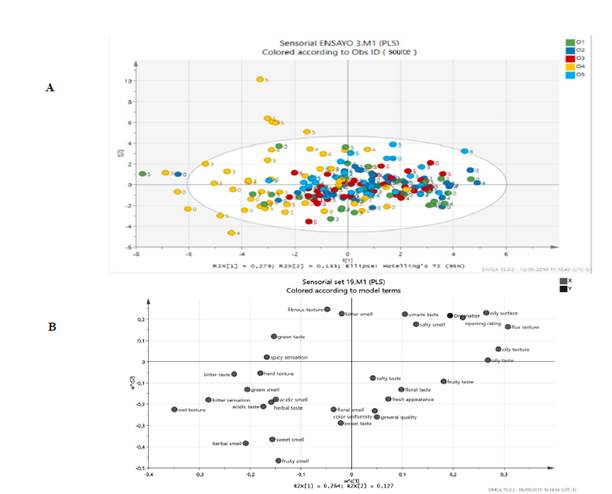
Source: The author
Figure 2 PLS A) score scatter plot and B) loadings scatter plot of DM as a numeric factor.
At the begging of the harvest season the oil Hass avocado content in Antioquia is low and is influence by the weather conditions [4]. The bitter flavor is a characteristic of immature avocado flesh, in many cases leaving a distinctive aftertaste on the palate. Literature indicates an association between the presence of ten C17 olefinic and acetylenic oxygenated aliphatic compounds with the ‘unpleasant bitter-type flavor’ [22]. Affective sensory test has shown that textural and flavor attributes are identified to be important by sensory panelists to determine the quality of the avocado eating experience. During avocado maturation fruit becoming creamier and less watery in texture with a flavor that is richer with less grassiness [16].
Even though there are some samples at 30% DM with low general quality, PLS (Fig. 2B) and VIP scores show that the main descriptors associated with the highest values of DM are flux texture, oily taste, oily texture, and fruity taste. These results are in accordance with those published by Obenland, et al. [16], who found that consumer likeability increased with advancing harvest date. Sensory panelists associated the increase in the hedonic score with greater richness, nuttiness and creaminess and a decline in the grassiness flavor. The oily taste and texture for 26% and 30% DM correspond to values of oil content from 12.5% a 15.2% published by Rodriguez, et al. [4] for the same orchards. However, more than just oil content is changed and is related to sensory descriptors. Other researchers reported that 12 aroma volatiles significantly changed in concentration during avocado maturation [16]. The sum of volatiles with a grassy aroma declined markedly during maturation. This observation could be the reason why herbal smells only appear at a low dry matter content in this work.
Different orchards at the same DM value (22%) have different descriptors. The O4 (2167 m.a.s.l.) samples have a low GQ compared to O3 (2464 m.a.s.l.) (Fig. 3). Oily texture, fruity taste, oily surface, and general quality were more related to high altitude. To establish if there were differences at similar altitudes or average temperatures, a PLS-DA (Fig. 4) taking m.a.s.l. as a categoric variable was performed. O3 (2464 m.a.s.l.) and O2 (2411 m.a.s.l.) were separated into two groups even though they have effectively the same climatic conditions (15.45°C and 15.86°C, respectively).
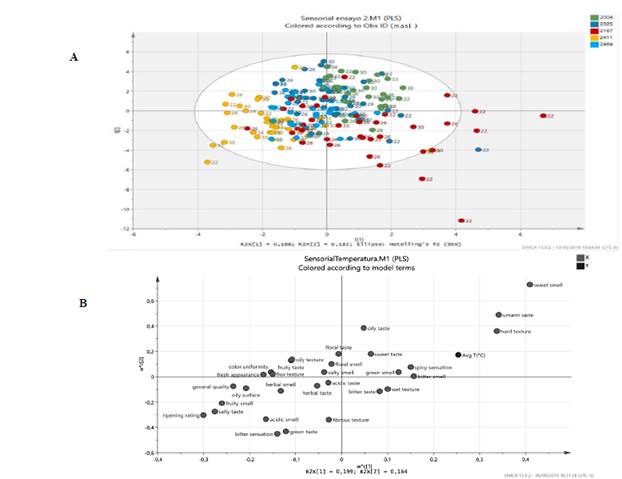
Source: The authors.
Figure 3 PLS A) score scatter plot and B) loadings scatter plot. of m.a.s.l. as a categorical factor.
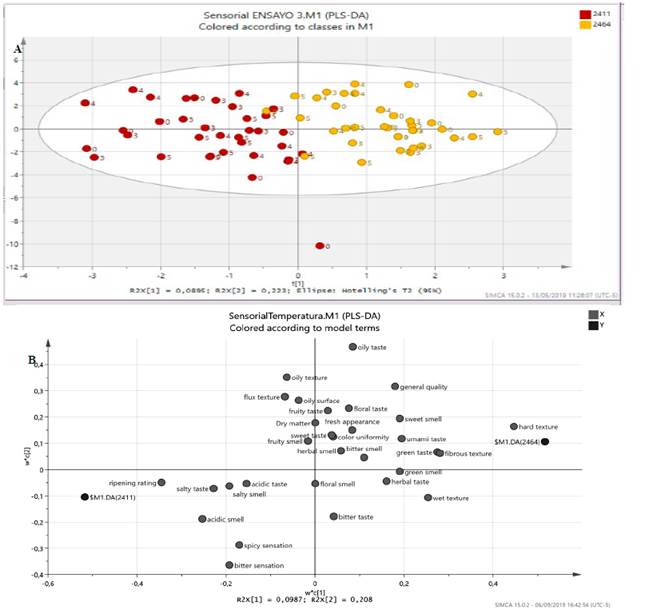
Source: The authors.
Figure 4 PLS-DA A) score scatter plot and B) loading scatter plot for m.a.s.l. as a categoric factor.
High altitudes or low average temperatures were related to better GQ. This finding could be possible because the orchards at low temperatures had a long fruit development time (220 d) compared to that of others (216 d) according to the results of Rodriguez et al. [4] for the same orchards.
At lower temperatures, the 18-carbon fatty acid content increased [23], that could be related to the high descriptors values of texture and oily surface for O2 and O3. However, at similar average temperatures, the results show differences between O3 and O2 on sensory descriptors. Mineral flesh composition, for those orchards was different. O3 had the highest Mg, K, N, Mn and B content (data not shown). According to Ferreyra, et al. [23] the N and Mg contents in the mesocarp were related to the contents of palmitic and palmitoleic acids, and when the levels of N and Mg increased in the mesocarp, the 16-carbon fatty acid content increased.
A LEAPS model was used to determine the best relationships between general quality and sensory descriptors. Fresh appearance and fruity taste had statistically significant relationships with GQ (P ≤ 0.05). The equation for the fitted model was GQ= -0.5615+ 0.46* fresh appearance + 0.32*fruity taste (R2 = 76.84).
Quadratic models have been applied to modeling the overall acceptability scores on avocado pulp [24]. In this work, surface responses methodology was used to stablish the effect of HI and ST on GQ. GQ is influenced by the orchard location, so that orchard order for GQ was O3 (3.26), O2 (2.81), O1 (2.76), O5 (2.71) and O4 (2.17). The GQ of the avocados at 22% DM is lower than that of fruits at 26 and 30% DM (2.58±0.05, 2.75±0.05 and 2.72±0.5, respectively). ST reduced fruit GQ, especially for O3, O4, and O5 (Fig. 5). GQ for O1 was significantly affected by the DM and the quadratic effect of DM, and the best GQ was found at 29% DM and 3 weeks of ST (Fig. 5A). For O2, a significance was observed for the effect of DM and the quadratic effect of DM, and 29% DM and 1 week of ST were the optimal values for GQ (Fig. 5B). In the response surface analysis, the quadratic effect of DM and ST had a significant effect on GQ for O3, and the optimal GQ was found at 28% DM and 1 week of ST (Fig. 5C). GQ was reduced with ST for O4, and the best factor combination (HI x ST) was 27% DM and 0 weeks of ST to achieve better sensory quality (Fig. 5D). Finally, ST as the main factor, and the quadratic effect of ST had a significant effect on GQ for O5, and the optimal GQ according to response surface could be found at 27% DM and 1 week of ST (Fig. 5E).
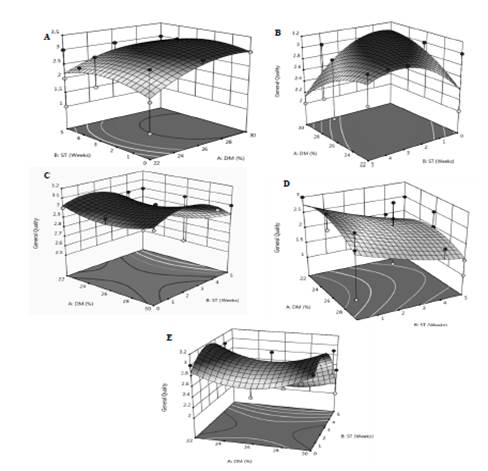
Source: The authors.
Figure 5 Effect of harvest index and storage time on fruit general quality. A) orchard 1, B) orchard 2, C) orchard 3, D) orchard 4, E) orchard 5.
There was a significant interaction of HI and ST on general quality. In general, the optimal GQ was found with DM> 26%, and ST reduced GQ after week 4. For O1, O2, O3 and O5, avocado fruits could withstand a long period of storage with few changes to GQ. However, for O4, GQ was drastically affected by storage. O4 had the highest: rainfall, mean maximum temperature, mean temperature, while its soil and flesh mineral content was the lowest (data not shown). During avocado storage there are metabolic changes. Propionic acid, succinic acid, mannoheptulose, perseitol, glucose, pentadienoic acid decreased with storage, while alanine, valine, phenylalanine, norleucine, increased [25]. Furthermore, has been reported that regular air cold storage for up to 37 days followed by ripening at shelf-life conditions increased the phenolic compounds [26]. Those changes could be related to the GQ sensory perception of Hass avocado at the “ready to eat” ripening stage.
4. Conclusions
Sensory descriptors have affected by the orchard location, at the low DM for some orchards, especially those that were located at high altitudes (low temperature, low rainfall, high soil and flesh mineral content) the GQ was better. Those orchards have a better sensory profile compare with orchard O4 (high temperature, high rainfall, low soil and flesh mineral content). Multivariate approach as data analysis method allowed to have the main sensory descriptors related to DM across the harvest season. GQ quality was related to color uniformity, fresh appearance, and fruity and floral smell. Fresh appearance and fruity taste had significance in a multiple linear regression with GQ. In contrast, bitter smell, fibrous texture, green smell, acid taste, acid smell and umami taste were the descriptors associated to a low general quality. Those descriptors were in fruit at low DM (19%), whereas that flux texture, oily taste, oily texture, and sweet taste were descriptors found in fruits at high DM. GQ was different between farms. The order from the high to low quality was O3, O2, O1, O5 and O4. HI an ST had a significant interaction on GQ. Fruit Harvest at the middle and late season and storage until 4 weeks could maintain a good GQ throughout the cold chain.














